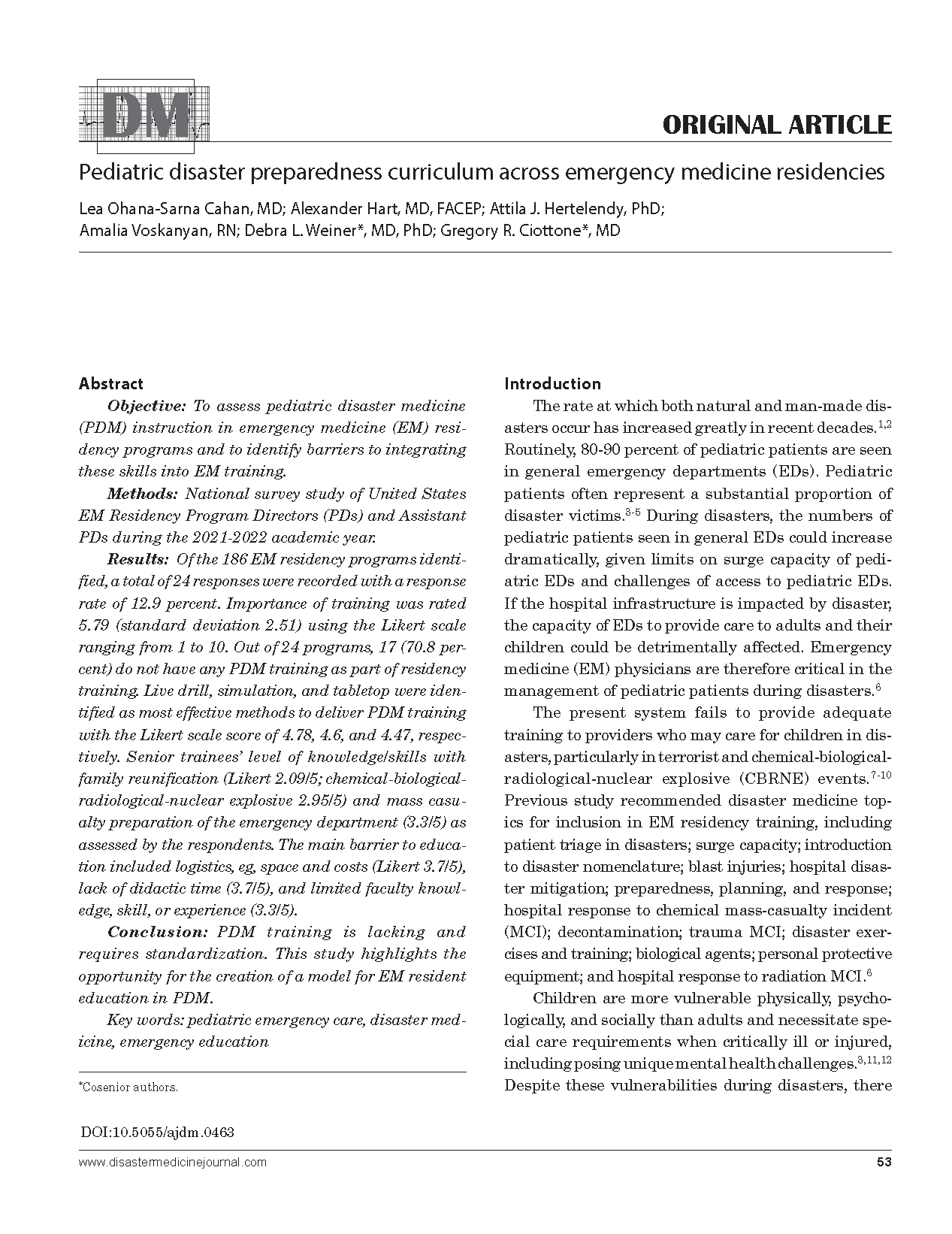Pediatric disaster preparedness curriculum across emergency medicine residencies
DOI:
https://doi.org/10.5055/ajdm.0463Keywords:
pediatric emergency care, disaster medicine, emergency educationAbstract
Objective: To assess pediatric disaster medicine (PDM) instruction in emergency medicine (EM) residency programs and to identify barriers to integrating these skills into EM training.
Methods: National survey study of United States EM Residency Program Directors (PDs) and Assistant PDs during the 2021-2022 academic year.
Results: Of the 186 EM residency programs identified, a total of 24 responses were recorded with a response rate of 12.9 percent. Importance of training was rated 5.79 (standard deviation 2.51) using the Likert scale ranging from 1 to 10. Out of 24 programs, 17 (70.8 percent) do not have any PDM training as part of residency training. Live drill, simulation, and tabletop were identified as most effective methods to deliver PDM training with the Likert scale score of 4.78, 4.6, and 4.47, respectively. Senior trainees’ level of knowledge/ skills with family reunification (Likert 2.09/5; chemical-biologicalradiological-nuclear explosive 2.95/5) and mass casualty preparation of the emergency department (3.3/5) as assessed by the respondents. The main barrier to education included logistics, eg, space and costs (Likert 3.7/5), lack of didactic time (3.7/5), and limited faculty knowledge, skill, or experience (3.3/5).
Conclusion: PDM training is lacking and requires standardization. This study highlights the opportunity for the creation of a model for EM resident education in PDM.
References
Hart A, Hertelendy A, Ciottone GR: Why every us hospital needs a disaster medicine physician now. Disaster Med Public Health Prep. 2020; 16: 1-2. DOI: 10.1017/dmp.2020.302. DOI: https://doi.org/10.1017/dmp.2020.302
Sarin RR, Hick JL, Livinski AA, et al.: Disaster medicine: A comprehensive review of the literature from 2016. Disaster Med Public Health Prep. 2019; 13(5-6): 946-957. DOI: 10.1017/dmp.2019.18. DOI: https://doi.org/10.1017/dmp.2019.18
Gnauck KA, Nufer KE, LaValley JM, et al.: Do pediatric and adult disaster victims differ? A descriptive analysis of clinical encounters from four natural disaster DMAT deployments. Prehosp Disaster Med. 2007; 22(1): 67-73. DOI: 10.1017/s1049023x00004362. DOI: https://doi.org/10.1017/S1049023X00004362
Gausche-Hill M, Ely M, Schmuhl P, et al.: A national assessment of pediatric readiness of emergency departments. JAMA Pediatr. 2015; 169(6): 527-534. DOI: 10.1001/jamapediatrics.2015.138. DOI: https://doi.org/10.1001/jamapediatrics.2015.138
Lozon MM, Bradin S: Pediatric disaster preparedness. Pediatr Clin North Am. 2018; 65(6): 1205-1220. DOI: 10.1016/j.pcl.2018.07.015. DOI: https://doi.org/10.1016/j.pcl.2018.07.015
Sarin RR, Biddinger P, Brown J, et al.: Core disaster medicine education (CDME) for emergency medicine residents in the United States. Prehosp Disaster Med. 2019; 34(5): 473-480. DOI: 10.1017/S1049023X19004746. DOI: https://doi.org/10.1017/S1049023X19004746
Scott LA, Carson DS, Greenwell IB: Disaster 101: A novel approach to disaster medicine training for health professionals. J Emerg Med. 2010; 39(2): 220-226. DOI: 10.1016/j.jemermed.2009.08.064. DOI: https://doi.org/10.1016/j.jemermed.2009.08.064
Martin SD, Bush AC, Lynch JA: A national survey of terrorism preparedness training among pediatric, family practice, and emergency medicine programs. Pediatrics. 2006; 118(3): e620-e626. DOI: 10.1542/peds.2005-1875. DOI: https://doi.org/10.1542/peds.2005-1875
Pesik N, Keim M, Sampson TR: Do US emergency medicine residency programs provide adequate training for bioterrorism? Ann Emerg Med. 1999; 34(2): 173-176. DOI: 10.1016/s0196-0644(99)70226-x. DOI: https://doi.org/10.1016/S0196-0644(99)70226-X
Fisher JD, Newton C, Kuhls D, et al.: Evaluating the MCI preparedness of US pediatric emergency departments. Pediatrics. 2022; 149(1): 20.
Krug SE, Bojko T, Dolan MA, et al.: The pediatrician and disaster preparedness. Pediatrics. 2006; 117(2): 560-564. DOI: 10.1542/peds.2005-2751. DOI: https://doi.org/10.1542/peds.2005-2751
Thompson T, Lyle K, Mullins SH, et al.: A state survey of emergency department preparedness for the care of children in a mass casualty event. Am J Disaster Med. 2009; 4(4): 227-232. DOI: https://doi.org/10.5055/ajdm.2009.0034
Gausche-Hill M: Pediatric disaster preparedness: Are we really prepared? J Trauma. 2009; 67(2): S73-S76. DOI: 10.1097/TA.0b013e3181af2fff. DOI: https://doi.org/10.1097/TA.0b013e3181af2fff
Disaster Preparedness Advisory Council; Committee on Pediatric Emergency Medicine: Ensuring the health of children in disasters. Pediatrics. 2015; 136(5): e1407-e1417. DOI: 10.1542/peds.2015-3112. DOI: https://doi.org/10.1542/peds.2015-3112
Harris PA, Taylor R, Thielke R, et al.: Research electronic data capture (REDCap)—A metadata-driven methodology and workflow process for providing translational research informatics support. J Biomed Inform. 2009; 42(2): 377-381. DOI: 10.1016/j.jbi.2008.08.010. DOI: https://doi.org/10.1016/j.jbi.2008.08.010
Gamble MS, Hanners RB, Lackey C, et al.: Leadership and hospital preparedness: Disaster management and emergency services in pediatrics. J Trauma—Inj Infect Crit Care. 2009; 67(Suppl.): 2. DOI: 10.1097/TA.0b013e3181af069f. DOI: https://doi.org/10.1097/TA.0b013e3181af069f
Sande MK, Broderick KB, Moreira ME, et al.: Sexual assault training in emergency medicine residencies: A survey of program directors. West J Emerg Med. 2013; 14(5): 461-466. DOI: 10.5811/westjem.2013.2.12201. DOI: https://doi.org/10.5811/westjem.2013.2.12201
Amini R, Adhikari S, Fiorello A: Ultrasound competency assessment in emergency medicine residency programs. Acad Emerg Med. 2014; 21(7): 799-801. DOI: 10.1111/acem.12408. DOI: https://doi.org/10.1111/acem.12408
Smith J, Levy MJ, Hsu EB, et al.: Disaster curricula in medical education: Pilot survey. Prehosp Disaster Med. 2012; 27(5): 492-494. DOI: 10.1017/S1049023X12001215. DOI: https://doi.org/10.1017/S1049023X12001215
Chung S, Baum CR, Nyquist AC, et al.: Chemical-biological terrorism and its impact on children. Pediatrics. 2020; 145(2). DOI: 10.1542/peds.2019-3750. DOI: https://doi.org/10.1542/peds.2019-3750
Blake N, Stevenson K: Reunification: Keeping families together in crisis. J Trauma. 2009; 67(2 Suppl.): S147-S151. DOI: 10.1097/TA.0b013e3181af0c13. DOI: https://doi.org/10.1097/TA.0b013e3181af0c13
Chung S, Shannon M: Reuniting children with their families during disasters: A proposed plan for greater success. Am J Disaster Med. 2007; 2(3): 113-117. DOI: https://doi.org/10.5055/ajdm.2007.0019
Chung S, Monteiro S, Ziniel SI, et al.: Survey of emergency management professionals to assess ideal characteristics of a photographic-based family reunification tool. Disaster Med Public Health Prep. 2012; 6(2): 156-162. DOI: 10.1001/dmp.2012.29. DOI: https://doi.org/10.1001/dmp.2012.29
Ballow S, Behar S, Claudius I, et al.: Hospital-based disaster preparedness for pediatric patients: How to design a realistic set of drill victims. Am J Disaster Med. 2008; 3(3): 171-180.
Ngo J, Schertzer K, Harter P, et al.: Disaster medicine: A multimodality curriculum designed and implemented for emergency medicine residents. Disaster Med Public Health Prep. 2016; 10(4): 611-614. DOI: 10.1017/dmp.2016.8. DOI: https://doi.org/10.1017/dmp.2016.8
Cicero MX, Brown L, Overly F, et al.: Creation and Delphi-method refinement of pediatric disaster triage simulations. Prehospital Emerg Care. 2014; 18(2): 282-289. DOI: 10.3109/10903127.2013.856505. DOI: https://doi.org/10.3109/10903127.2013.856505
Gout L, Hart A, Houze-Cerfon C-H, et al.: Creating a novel disaster medicine virtual reality training environment. Prehosp Disaster Med. 2020; 35(2): 225-228. DOI: 10.1017/S1049023X20000230. DOI: https://doi.org/10.1017/S1049023X20000230

Published
How to Cite
Issue
Section
License
Copyright 2007-2025, Weston Medical Publishing, LLC and American Journal of Disaster Medicine. All Rights Reserved.

